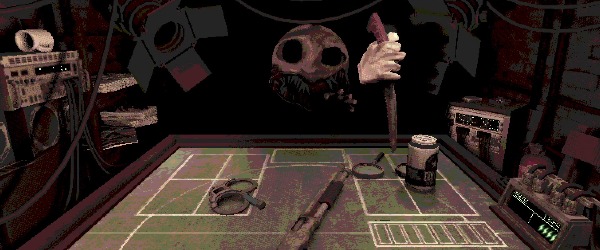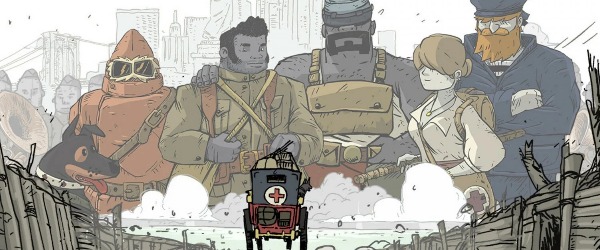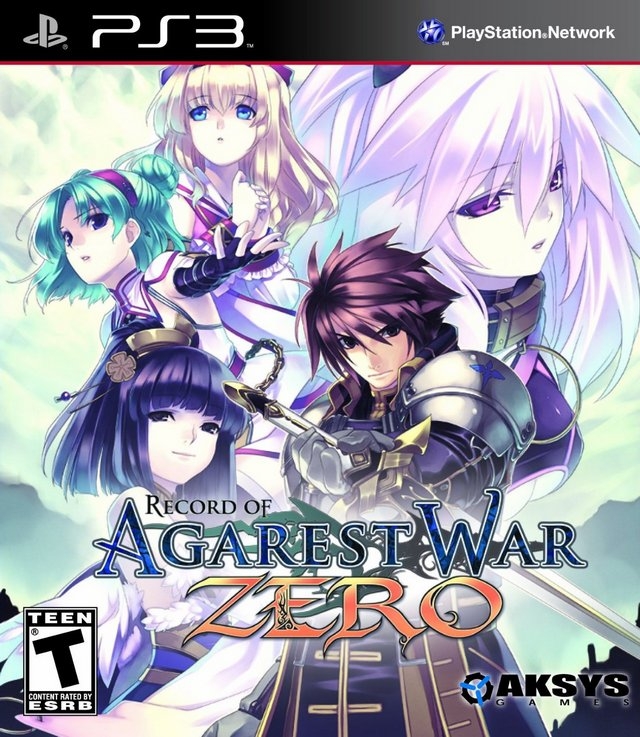
Record of Agarest War Zero - Review
by Karl Koebke , posted on 14 July 2011 / 12,946 Views
Say what you will about the low number of console JRPG releases this generation, but each one will keep you busy for quite a long time. Record of Agarest War Zero will give you hundreds of hours of playtime if you care to delve into it fully. I just wish those hours were more enjoyable.
Record of Agarest War Zero is the prequel to Record of Agarest War, so newcomers should have no trouble picking up the story. It’s a fairly typical JRPG story about a great war between good and evil, and you eventually get set on a mission to gather artifacts in order to defeat the dark forces. The unique thing about the Agarest War series is that each game spans multiple generations of characters. It’s an interesting method of making your romantic decisions throughout the first half of the game have a large impact on the later half. Unfortunately this iteration of the series only has three choices for who you end up with in the first generation and only two generations total, whereas the first game actually went on for 5 generations, so there isn’t as much riding on the system as one would hope. Basically, all you end up being able to affect is the second main character’s (your first main character’s son's) stats and personality.
Record of Agarest War Zero is the prequel to Record of Agarest War, so newcomers should have no trouble picking up the story. It’s a fairly typical JRPG story about a great war between good and evil, and you eventually get set on a mission to gather artifacts in order to defeat the dark forces. The unique thing about the Agarest War series is that each game spans multiple generations of characters. It’s an interesting method of making your romantic decisions throughout the first half of the game have a large impact on the later half. Unfortunately this iteration of the series only has three choices for who you end up with in the first generation and only two generations total, whereas the first game actually went on for 5 generations, so there isn’t as much riding on the system as one would hope. Basically, all you end up being able to affect is the second main character’s (your first main character’s son's) stats and personality.
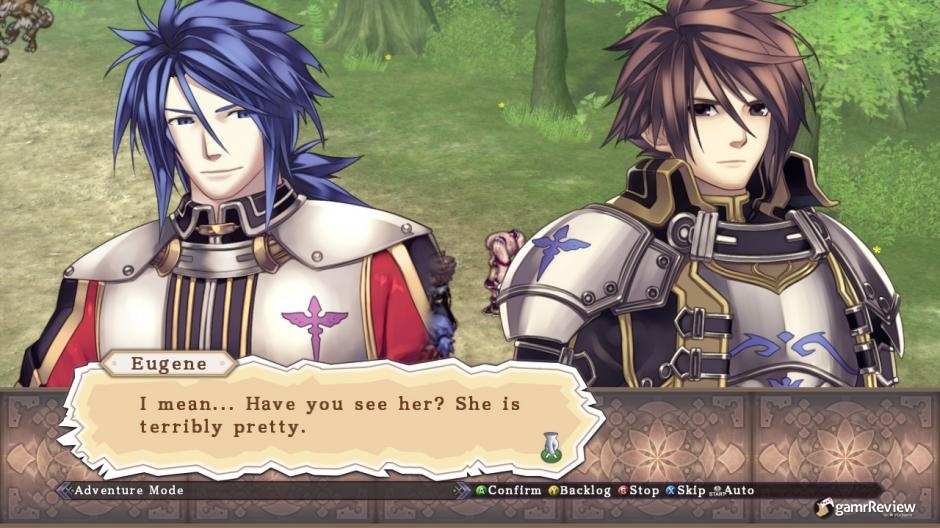
Good luck picking a specific bride though, because when I went through the game I had no idea that only three of the girls in the sizeable harem I had accumulated were plausible mates (there was a hint at the oracle in town, but I didn’t catch it at the time). So I just chose the girl I wanted based on my own personal sick perversions and ended up only being in the favor of one of the actual choices so my decision was made for me. That said, even if I’d known my three possible targets I probably wouldn’t have been able to get the girl I actually wanted simply because of how confusing the system is for wooing them.
Throughout the game I was given dialogue choices, but they would almost always affect multiple people. So you end up decreasing your affection for characters that weren’t even in the conversation to begin with. Apparently everyone but you has a daily meeting to learn about everything you said to every girl in your group just so they can react to it in some way. Luckily there are also vacation days during which talking to a girl will only ever increase her affection for you, but there aren’t enough of these to make up for your mistakes if you screw up too much during conversation. All this just so you can have a few still images of the girls you manage to make love you in suggestive situations, it’s the most you’ll ever work for porn. If that’s your reason for playing I suggest just finding the images when they’re put online like a normal person.
Luckily the battle system is far less confusing than trying to pick up girls (should have seen that coming, honestly), once you get past the strange character creation system. After you select the obvious choice between Warrior, Battle Mage, and Sorcerer you choose five additional cards from a possible 24, all with differing weapons and stat affinities associated with them. It’s quite a daunting start to a game, with little to no explanation, so hopefully you get lucky. I just chose everything I could with a sword associated with it, and called it a day.
Throughout the game I was given dialogue choices, but they would almost always affect multiple people. So you end up decreasing your affection for characters that weren’t even in the conversation to begin with. Apparently everyone but you has a daily meeting to learn about everything you said to every girl in your group just so they can react to it in some way. Luckily there are also vacation days during which talking to a girl will only ever increase her affection for you, but there aren’t enough of these to make up for your mistakes if you screw up too much during conversation. All this just so you can have a few still images of the girls you manage to make love you in suggestive situations, it’s the most you’ll ever work for porn. If that’s your reason for playing I suggest just finding the images when they’re put online like a normal person.
Luckily the battle system is far less confusing than trying to pick up girls (should have seen that coming, honestly), once you get past the strange character creation system. After you select the obvious choice between Warrior, Battle Mage, and Sorcerer you choose five additional cards from a possible 24, all with differing weapons and stat affinities associated with them. It’s quite a daunting start to a game, with little to no explanation, so hopefully you get lucky. I just chose everything I could with a sword associated with it, and called it a day.
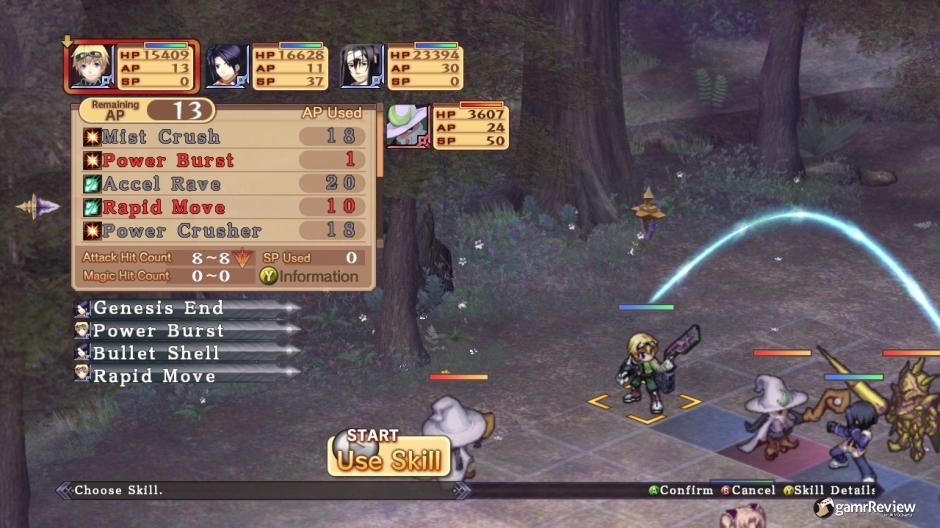
Once past that hurdle you get into the meat of the game, which is a fairly simplistic, grid-based SRPG set up. Each battle takes place on a small grid with your six characters and your enemies. Moving around occurs how you would expect from an SRPG, with movement taking up AP which is also used for attacking. Layers of complexity are added when you start thinking about placing your troops in order to allow combos, and this is necessary if you want to get anywhere in the game.
Every character has an extended area which is a pattern of spaces around them, and if you place another one of your characters in this space, the two will be linked. This has a huge number of benefits such as allowing them to perform combos and taking away the range requirements for their attacks. So, each turn you do your best to link all of your characters together if at all possible, but your opponents can then use skills to knock your units around and screw up all of your careful planning. I can’t tell you how many times I cursed the day I was born when this happened at a crucial moment in a boss fight and since you can only move characters to specific places during the start of the overall turn and not during, it is usually next to impossible to get your links back after they’ve been all muddled up.
If I had to name only two important aspects to the battle system it would be the extended area management I mentioned above, and point management. There are all kinds of points (HP, XP, AP, EP, PP, TP, SP to name them all) but the most important ones are AP and SP. AP is what you use to do all of your attacks and is replenished automatically each turn with a small bonus based on how you manage the extended area (just one more reason it’s hugely important). SP is used for special attacks and is gained by attacking the enemy, killing enemies, or when an ally dies. And die they shall - in almost every fight in this game I had characters dying, quite often in the very first turn before any of my units had had a chance to do anything about it. My advice is to stock up on “Fragments of Life” and never put any character so far away from others that he can’t be saved. You only get two turns to revive them before they’re out for the rest of the battle, so be careful.
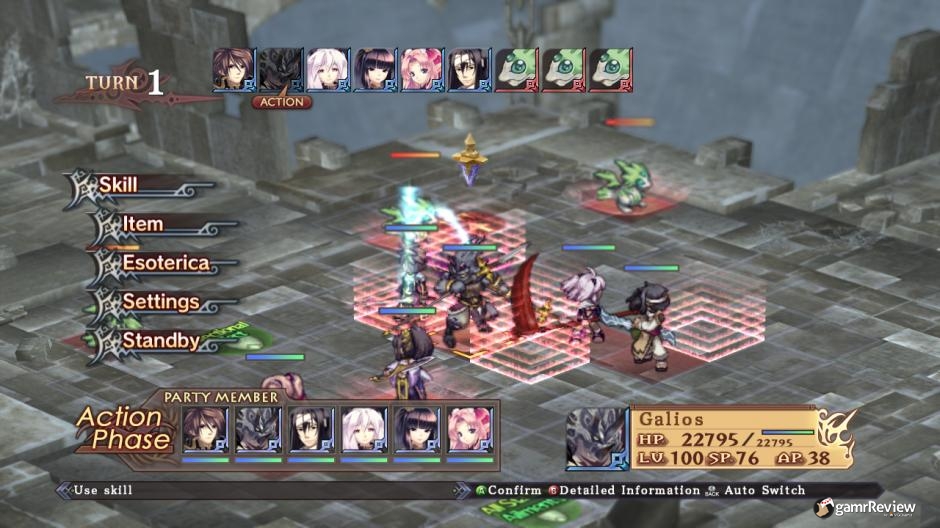
Another important note about SP is that it’s not unique to your units: the enemy has it as well. So if you let the fight drag on for too long suddenly you are going to have some mighty attacks being swung your way, which will probably take some people out if you’re unlucky. If you’re extremely unlucky the monster will have a special that will take out several of your characters at once, which will then earn it enough SP to do the damned attack again the next turn. Boss fights are rife with this issue and almost all of them end in a war of attrition as I try to let them kill off as few people as possible with their special each turn and save up enough of my own SP to finish them off. Most of these bosses can kill at least one character each turn without any help from SP, so also letting them get into this endless loop of multi-unit killing specials is just salt in the wound.
This is the kind of game that makes each boss less of a hurdle and more of a three-storey Superman leap. I was stuck grinding out a couple hours before quite a few of these which is something I usually loath doing. I just can’t help but consider my need to grind as an issue of pacing that the developers are ignoring based on the idea that their fan base likes to grind. They really make every attempt to draw out the grinding too with characters only earning experience when they actually participate in a battle, so you’ll probably have a number of weak unused characters simply because leveling them up to keep up with your regular troupe would be too much of a chore.
Setting up the experience system like this actually makes it possible to get completely screwed at the start of the second generation, since four of your characters are taken away without warning, putting you into a rather difficult series of fights. Fortunately I didn’t happen to use all four of these characters, so I was able to make it through, but I could definitely see this stopping some people, so let me just say that the four characters you’ll lose are Sieghart, Friedelinde, Routier, and Sayane. There is actually a method to get them back, but by the time you can afford it you probably won’t want them.
This is the kind of game that makes each boss less of a hurdle and more of a three-storey Superman leap. I was stuck grinding out a couple hours before quite a few of these which is something I usually loath doing. I just can’t help but consider my need to grind as an issue of pacing that the developers are ignoring based on the idea that their fan base likes to grind. They really make every attempt to draw out the grinding too with characters only earning experience when they actually participate in a battle, so you’ll probably have a number of weak unused characters simply because leveling them up to keep up with your regular troupe would be too much of a chore.
Setting up the experience system like this actually makes it possible to get completely screwed at the start of the second generation, since four of your characters are taken away without warning, putting you into a rather difficult series of fights. Fortunately I didn’t happen to use all four of these characters, so I was able to make it through, but I could definitely see this stopping some people, so let me just say that the four characters you’ll lose are Sieghart, Friedelinde, Routier, and Sayane. There is actually a method to get them back, but by the time you can afford it you probably won’t want them.
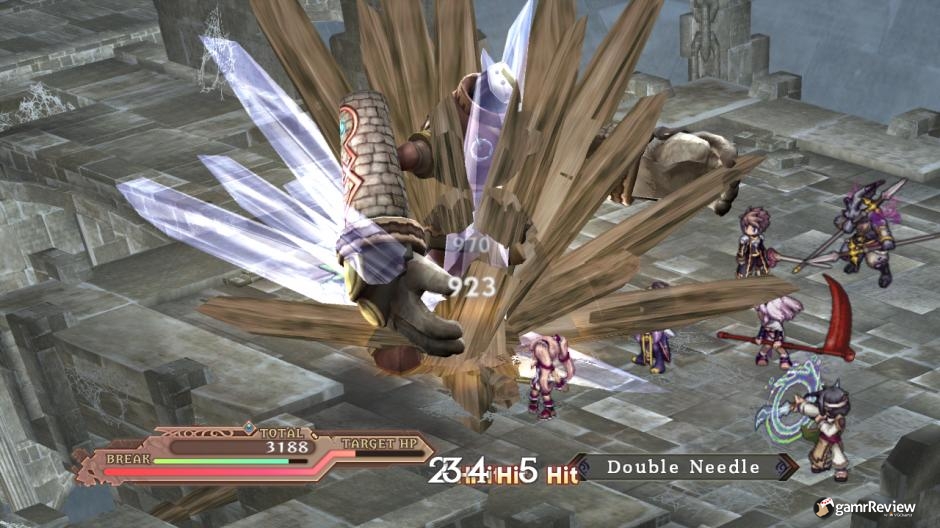
Now you might be thinking to yourself “But Karl, just because a game is hard doesn’t mean it’s bad: lots of people (including you) loved Demon’s Souls”. It’s true that just being difficult isn’t necessarily a bad thing, but it’s all about how the game is difficult. In Record of Agarest War Zero I almost never felt like I died because I made a mistake that I should learn from. Instead, it felt like I always lost fights due to luck, or not having grinded to a high enough level to stand a chance. That is not the fun kind of difficulty which we should be praising. Demon’s Souls was all about learning to play cautiously again and figuring out how to approach each battle, but the approach in Agarest War is always the same. If you are failing, you should probably just go grind. Sure, I felt a sense of satisfaction after finally beating a boss fight after hours of attempts and grinding, but every moment before that was a giant grind, trudge through the swamp, slog through the mud, or whatever you want to call it, so the two don’t really balance out.
There are a number of free DLC packs available that can give you a much needed boost, and I highly suggest using them if you get stuck later in the game. Having the items that these DLC give you would break the beginning of the game but really only make later sections barely passable. I used every single free boost and piece of equipment I could get and still just barely managed to beat the final boss after playing for 74 hours and leveling to the point where I was actually five levels over her, so don’t worry about this making the game a breeze.
Speaking of that 74 hours, that was just what it took for me to get the crappy ending. That’s right, even after all that work I didn’t even manage to get any real closure from the story. Now I understand that some JRPG developers like to do this so that you have incentive to keep working the 30, 40, or maybe even 50 more hours it would take to get the true ending, but I really wish they wouldn’t make the normal ending quite so crappy. Or at least make it easier to obtain the true ending. If you screw up your playthrough and get the less than perfect ending in Record of Agarest War Zero your only option is to restart from the beginning in either normal or EX mode which makes things even harder and you unlock after finishing the normal campaign. It isn’t like Persona 4 where if you get the bad ending you just have to go back to an obvious decision 30 minutes or so ago and change your choice to get the normal ending, or work 10-20 more hours beyond that for the true ending. If you want the true ending in this game you are going to have to put untold hours into all kinds of different things, and I just don’t see why you would.
There are a number of free DLC packs available that can give you a much needed boost, and I highly suggest using them if you get stuck later in the game. Having the items that these DLC give you would break the beginning of the game but really only make later sections barely passable. I used every single free boost and piece of equipment I could get and still just barely managed to beat the final boss after playing for 74 hours and leveling to the point where I was actually five levels over her, so don’t worry about this making the game a breeze.
Speaking of that 74 hours, that was just what it took for me to get the crappy ending. That’s right, even after all that work I didn’t even manage to get any real closure from the story. Now I understand that some JRPG developers like to do this so that you have incentive to keep working the 30, 40, or maybe even 50 more hours it would take to get the true ending, but I really wish they wouldn’t make the normal ending quite so crappy. Or at least make it easier to obtain the true ending. If you screw up your playthrough and get the less than perfect ending in Record of Agarest War Zero your only option is to restart from the beginning in either normal or EX mode which makes things even harder and you unlock after finishing the normal campaign. It isn’t like Persona 4 where if you get the bad ending you just have to go back to an obvious decision 30 minutes or so ago and change your choice to get the normal ending, or work 10-20 more hours beyond that for the true ending. If you want the true ending in this game you are going to have to put untold hours into all kinds of different things, and I just don’t see why you would.
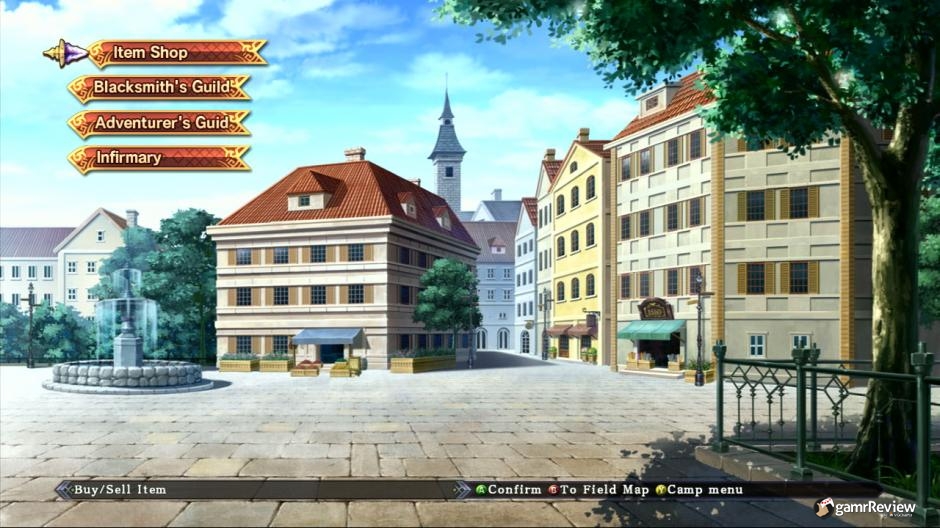
Luckily not all of the value comes just from forced grinding and repeating the story, you also have tons of side stuff to do while playing. There are all kinds of activities to do to the point that I didn’t even touch on a few like capturing and combining your own monsters. You could probably spend hundreds of hours earning all of the different titles the game has which are rewards for accomplishing things like having 100,000 gold or blacksmithing one thousand items. So again, if you are the kind of person that enjoys grinding for the sake of grinding then you will probably be busy for months, but again there is little reason beyond the pure joy of grinding to put the effort into it.
By far the game’s worst aspect is the presentation. The sprites have your classic PS1 dated look, and the still image presentation that the developers used for games like Trinity Universe and Hyperdimension Neptunia doesn’t really work for the serious subject matter. Characters end up looking like breathing dolls with independently moving lips and are much less expressive than in the previous games. Couple that with the audio all being in Japanese, and everything comes off as rather stale. It’s hard to get excited about something happening in the story when the people participating in that story seem like they barely care at all. All they ever do is stand in the same pose with almost imperceptibly changing facial expressions. At least in a game like Hyperdimension Neptunia the lighter subject material allowed the developers to use a more grandiose anime-based set of expressions that gave things more variety. The system just doesn’t seem fit for anything too serious. Gameplay during battle and combo attacks look nice enough, but with all the grinding I had to do, I turned the effects off before long.
By far the game’s worst aspect is the presentation. The sprites have your classic PS1 dated look, and the still image presentation that the developers used for games like Trinity Universe and Hyperdimension Neptunia doesn’t really work for the serious subject matter. Characters end up looking like breathing dolls with independently moving lips and are much less expressive than in the previous games. Couple that with the audio all being in Japanese, and everything comes off as rather stale. It’s hard to get excited about something happening in the story when the people participating in that story seem like they barely care at all. All they ever do is stand in the same pose with almost imperceptibly changing facial expressions. At least in a game like Hyperdimension Neptunia the lighter subject material allowed the developers to use a more grandiose anime-based set of expressions that gave things more variety. The system just doesn’t seem fit for anything too serious. Gameplay during battle and combo attacks look nice enough, but with all the grinding I had to do, I turned the effects off before long.
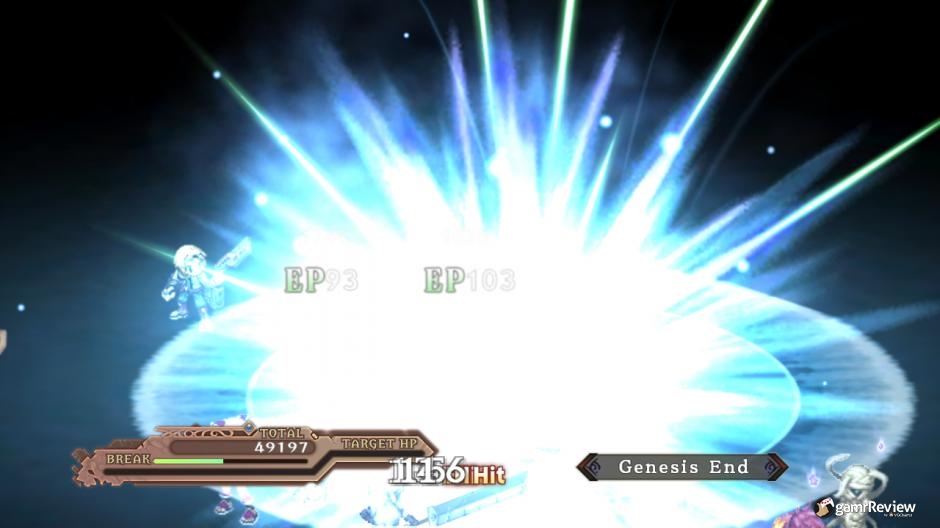
Record of Agarest War Zero is the kind of game I play just to prove that I can, to be honest. I made it through and now my JRPG fan street cred has been renewed for another year or so. It’s not a terrible game, but I really don’t see it as anything above decent, if even that. Bad presentation and grind heavy gameplay is mitigated by how much you could get out of it if it turns out you like it. Of course if you really like grinding that much maybe some day I’ll make an endless cycling game just to see if you’ll actually play it forever. Or I could just direct you towards World of Warcraft (insert evil cackle here).
VGChartz Verdict
5.5
Acceptable








